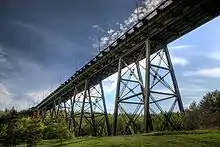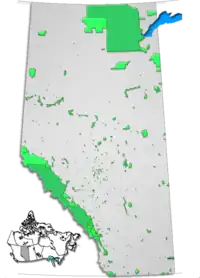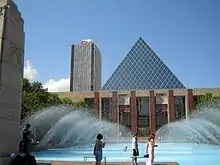North Saskatchewan River valley parks system
The North Saskatchewan River valley parks system (Also known as River Valley Parks; and Ribbon of Green)[1][2] is a continuous collection of urban parks in the North Saskatchewan River valley of Edmonton, Alberta. The parks range from waterside to cliff side to cliff top locations bordering the North Saskatchewan River.
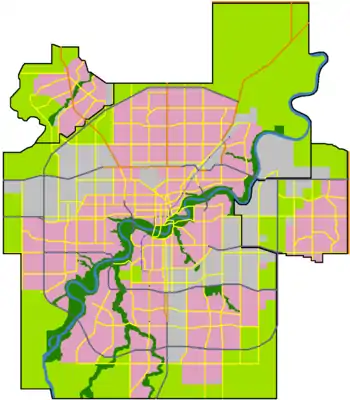
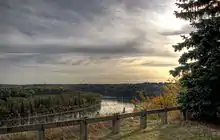
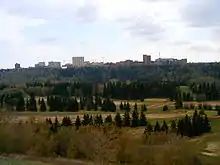
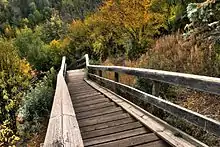
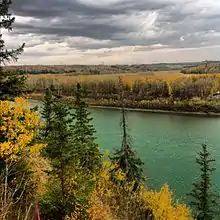
Edmonton's river valley comprises over 20 major parks and attractions and forms the largest expanse of urban parkland in Canada.[1][2] The public river valley parks provide a unique urban escape area with park styles ranging from fully serviced urban parks to campsite-like facilities with few amenities. At 7,400 ha (18,000 acres) in size and 48 km (30 mi) in length, the river valley parks system includes 22 ravines, which have a combined total length of 103 km (64 mi).[2] It also includes 11 lakes. Most of the city has bicycle and walking trail connections.[3] These trails are also part of the 309 km (192 mi) Waskahegan walking trail.
Several golf courses, both public and private, are also located in the river valley. The long summer daylight hours of this northern city provide for extended play well into the evening. Golf courses and the park system become a winter recreation area during this season. Cross-country skiing and skating are popular during the long winter. Four downhill ski slopes are located in the river valley as well, two within the city and two immediately outside.
The City of Edmonton has named five parks in its river valley parks system in honour of each of "The Famous Five".
Parks and facilities
The largest share of the protected areas in the river valley is occupied by various municipal parks. Located on both sides of the North Saskatchewan River, moving from west to east along the river, are:[4][5]
- Terwillegar Park - south bank
- Oleskiw River Valley Park - north bank
- Whitemud Park (also known as Whitemud Creek)- south bank
- Sir Wilfrid Laurier Park - north bank
- Buena Vista Park - north bank
- William Hawrelak Park - south bank
- McKinnon Ravine Park - north bank
- Government House Park - north bank
- Emily Murphy Park (named for one of Alberta's/Canada's "Famous Five") - south bank
- Victoria Park - north bank
- Kinsmen Park - south bank
- Queen Elizabeth Park - south bank
- Nellie McClung Park ("Famous Five") - south bank
- Irene Parlby Park ("Famous Five") - north bank
- Rossdale Park - north bank
- Louise McKinney Park ("Famous Five") - north bank
- Henrietta Muir Edwards Park / Rafters Landing ("Famous Five") - south bank
- Mill Creek Ravine Park - south bank
- Gallagher Park - south bank
- Riverdale Park - north bank
- Allan Stein Park - north bank
- Forest Heights Park - south bank
- Dawson Park - north bank
- Kinnaird Park and Ravine - north bank
- Capilano Park - south bank
- Gold Bar Park - south bank
- Floden Park - north bank
- Tiger Goldstick Park - south bank
- Rundle Park - north bank
- Hermitage Park - north bank
The City also operates several public facilities in the river valley:
- Fort Edmonton Park
- Edmonton Valley Zoo
- Muttart Conservatory
- John Janzen Nature Centre
- Riverside Golf Course
- Victoria Golf Course (the oldest municipal course in Canada)
- Rundle Park Golf Course
The provincial government owns the following sites in the river valley:
Hiking, cycling, and multi-use trails run throughout these parks and connect to other trails through the city and outside as well forming an integrated system. The river valley parks in particular are part of the Waskahegan and Trans Canada trail systems.
Wildlife
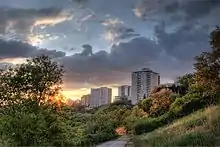
Edmonton's river valley park system is home to porcupines, deer, coyotes, skunks, muskrats, hares, and beavers.
Edmonton's streets and parklands are also home to one of the largest remaining concentrations of healthy American Elm trees in the world, unaffected by Dutch Elm disease, which has wiped out vast numbers of such trees in eastern North America. Jack Pine, Lodgepole Pine, White Spruce, White Birch, Aspen, Green Ash, Basswood, various poplars and willows, and Manitoba Maple are also abundant; Bur Oak is increasingly popular. Introduced tree species include Blue Spruce, Norway Maple, Red Oak, Sugar Maple, Common Horse-chestnut, McIntosh Apple, and Evans Cherry. Three walnut species -- Butternut, Manchurian Walnut and Black Walnut—have survived in Edmonton.[6]
Politics and planning
The idea of uniting the parks of the river valley into one parks system dates back to at least the 1970s. In 1974, Alberta Premier Peter Lougheed announced the creation of the Capital City Recreation Park, consisting of a 14.5-kilometre (9.0 mi) stretch of parks from the Legislature grounds east to the Beverly Bridge at an estimated cost of $30–35 million.[7]
The River Valley Alliance is a grouping of municipal governments in the Edmonton region that have committed to expanding the River Valley Parks System outside of Edmonton's city limits. The plan calls for a 18,000-acre (73 km2) zone to be called the Capital Region Valley Park stretched over 88 kilometres running from Devon to Fort Saskatchewan.[2]
In January 2008, the City of Edmonton paid a record C$7 million to buy a parcel of land to fill in a gap in the otherwise continuous chain of parks. The city further promised to spend C$20 million of pedestrian bridges and trails, but said that the as yet unnamed park would be left in an undeveloped state.[8]
See also
References
| Wikimedia Commons has media related to North Saskatchewan River Valley in Edmonton. |
- "River Valley Parks". City of Edmonton. Retrieved 31 March 2016.
- "Capital Region River valley". River Valley Alliance. River Valley Alliance. Retrieved 31 March 2016.
- "Edmonton Roadway Bicycle Map" (PDF). City of Edmonton, Transportation Department. January 2007. Archived from the original (PDF) on 2007-10-29. Retrieved 2007-10-27.
- "City of Edmonton Neighbourhood Interactive Map". City of Edmonton. 2018-07-12. Retrieved 2018-07-12.
- "Ribbon of Green; Recreation Assessment" (PDF). "O2 Planning + Design Inc." & "RC Strategies + PERC". City of Edmonton. September 2017. Retrieved 2018-07-12.
- Barkley, Shelley (2007-05-22). "Juglans sp. (Butternut/Walnut)". Government of Alberta. Archived from the original on 2007-09-21. Retrieved 2007-10-27.
- Article. canada.com. Retrieved on 2013-08-13.
- "Filling a gap in valley trail system". Edmonton Journal. 2008-01-05. Archived from the original on 2012-11-03. Retrieved 2008-01-07.
